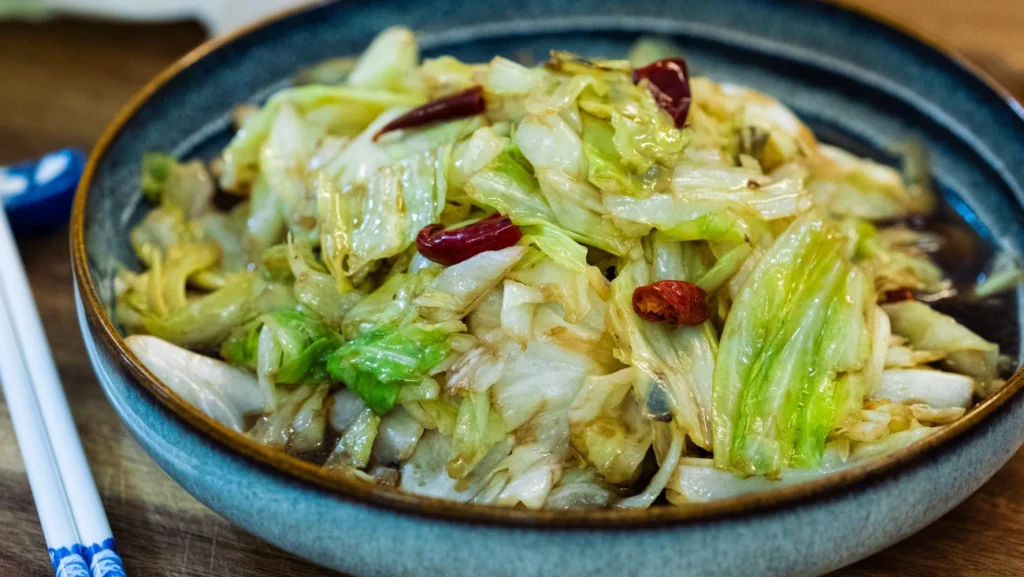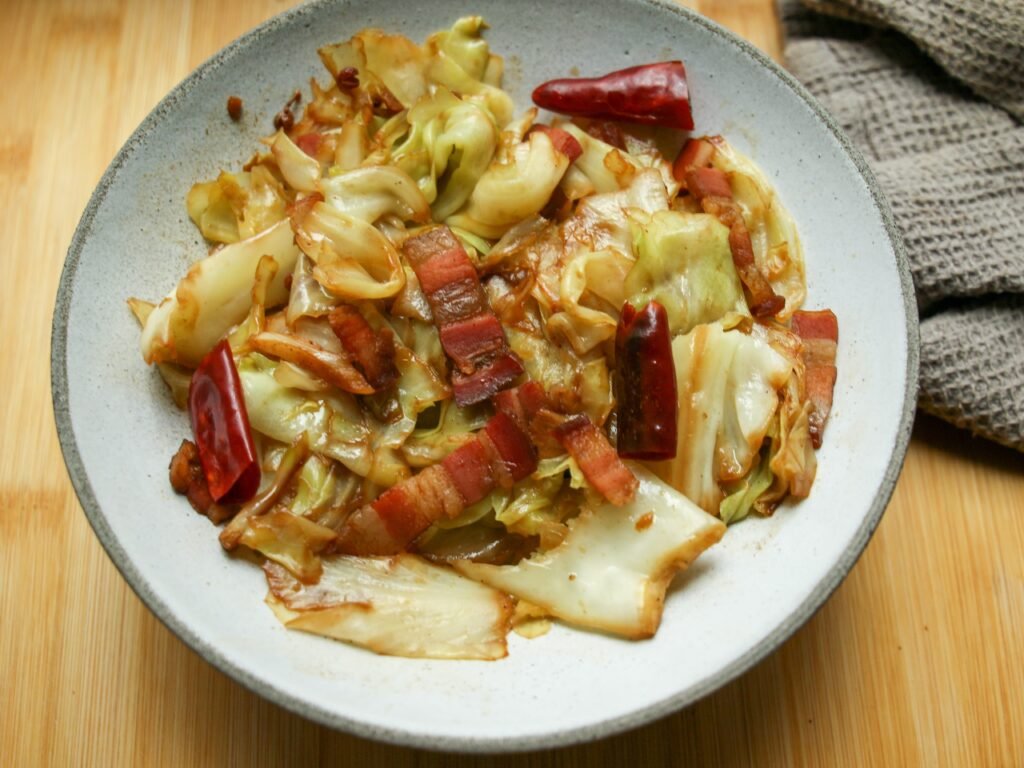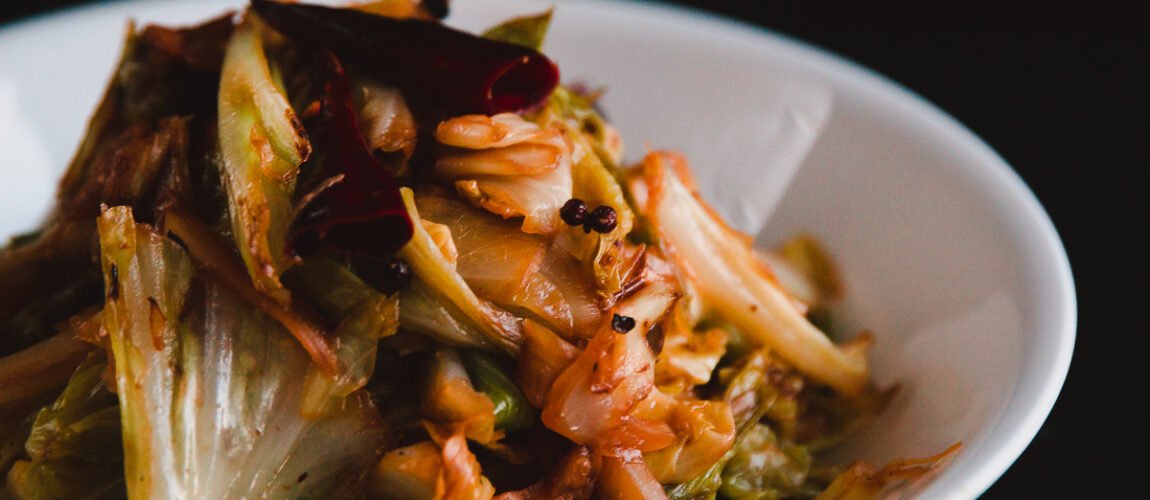Why Stir-Fried Hand-Torn Cabbage?
Cabbage, often overlooked, is a nutritional powerhouse and a stir-fry superstar. Stir-Fried Hand-Torn Cabbage is:
- Quick and Easy: Ready in 10–15 minutes, perfect for busy schedules.
- Healthy: Low in calories, high in fiber, and packed with vitamins C and K.
- Budget-Friendly: Cabbage is inexpensive and widely available year-round.
- Versatile: Serve as a side, a main with protein, or over rice for a complete meal.
- Customizable: Adapt with spices, proteins, or sauces to suit any palate.
- Gluten-Free and Vegan-Friendly: Easily tailored for dietary needs.
The hand-torn method adds a rustic charm, allowing the cabbage to cook unevenly for a mix of tender and crisp textures. The high-heat stir-fry technique locks in flavor and nutrients, making this dish as wholesome as it is delicious.
The Recipe: Stir-Fried Hand-Torn Cabbage
Below is a detailed recipe for Stir-Fried Hand-Torn Cabbage, inspired by sources like The Woks of Life and China Sichuan Food, with adjustments for clarity and accessibility. This recipe serves 4 as a side or 2 as a main, with a prep time of 5 minutes and a cooking time of 5–7 minutes, totaling about 15 minutes. The result is a vibrant, flavorful dish that’s perfect for any meal.
Ingredients
For the Stir-Fry:
- 1 medium head of green cabbage (about 1.5 lbs, preferably Napa or Savoy for tenderness)
- 2 tbsp vegetable oil (e.g., peanut, canola, or avocado for high heat)
- 3 cloves garlic (minced, about 1 tbsp)
- 1-inch piece fresh ginger (peeled and minced, about 1 tsp)
- 2 green onions (sliced, white and green parts separated)
- 1–2 dried red chilies (optional, for heat; or ½ tsp red chili flakes)
- 1 tbsp low-sodium soy sauce (or tamari for gluten-free)
- 1 tsp rice vinegar (for tanginess)
- 1 tsp sesame oil (for nutty aroma)
- ½ tsp sugar (to balance flavors)
- ¼ tsp salt (or to taste)
- Freshly ground black pepper (to taste)
For Optional Add-Ins:
- 1 small carrot (julienned, for color and crunch)
- ½ cup sliced mushrooms (e.g., shiitake or cremini, for umami)
- ¼ cup toasted peanuts or sesame seeds (for crunch)
- 200g firm tofu or cooked chicken (cubed, for protein)
- 1 tsp oyster sauce (or hoisin for vegetarian, for richer flavor)
Instructions
- Prepare the Cabbage:
- Remove any wilted outer leaves from the cabbage. Rinse under cold water and pat dry with a clean towel.
- Tear cabbage into bite-sized pieces (about 2–3 inches) by hand, discarding the tough core. Irregular shapes are ideal for texture. If using Napa cabbage, separate leaves and tear gently to avoid bruising.
- Prep Aromatics:
- Mince garlic and ginger finely to ensure even distribution of flavor.
- Slice green onions, keeping white parts for cooking and green parts for garnish.
- If using dried red chilies, break them in half to release flavor (remove seeds for less heat).
- Make the Sauce:
- In a small bowl, mix soy sauce, rice vinegar, sesame oil, sugar, and salt. Stir until sugar dissolves. Set aside.
- Stir-Fry the Cabbage:
- Heat a wok or large skillet over high heat until smoking hot (a drop of water should sizzle and evaporate instantly).
- Add vegetable oil and swirl to coat the wok. Add garlic, ginger, white parts of green onions, and dried red chilies (if using). Stir-fry for 10–15 seconds until fragrant, taking care not to burn the garlic.
- Add hand-torn cabbage (and optional carrots or mushrooms). Stir-fry for 2–3 minutes, tossing constantly with tongs or a spatula, until cabbage wilts slightly but retains some crunch. The edges should char lightly for flavor.
- If using tofu or chicken, add now and stir-fry for 1–2 minutes until heated through.
- Add Sauce and Finish:
- Pour the prepared sauce over the cabbage, tossing to coat evenly. Stir-fry for 30–60 seconds until the sauce is absorbed and the cabbage is tender-crisp.
- Taste and adjust with a pinch of salt or black pepper if needed. If using oyster or hoisin sauce, add now and toss briefly.
- Remove from heat and transfer to a serving plate. Garnish with green onion tops and optional peanuts or sesame seeds.
- Serve:
- Serve immediately as a side with rice, noodles, or a protein main (e.g., mapo tofu or grilled fish). For a complete meal, serve over steamed jasmine rice or quinoa, topped with extra garnishes.
Dietary Notes
- Vegan: Naturally vegan without optional oyster sauce or chicken. Use hoisin or mushroom sauce for umami.
- Gluten-Free: Use tamari or gluten-free soy sauce. Ensure optional sauces are gluten-free.
- Low-Carb/Keto: Cabbage is low-carb (about 4g net carbs per cup). Omit sugar or use a keto-friendly sweetener; avoid starchy add-ins like carrots.
- Low-Sodium: Use low-sodium soy sauce and reduce salt. Add more vinegar or ginger for flavor.
Nutritional Highlights (Per Serving, Approx., as a Side)
- Calories: 100–120 kcal
- Protein: 2–3g (from cabbage; more with tofu or chicken)
- Carbs: 8–10g (from cabbage and optional carrots)
- Fiber: 3–4g (from cabbage)
- Fat: 7–9g (from oil and sesame seeds)
- Sodium: 400–500mg (from soy sauce and salt)
Cabbage is rich in vitamins C and K, supporting immunity and bone health, and high in fiber for digestion. Ginger and garlic offer anti-inflammatory and antimicrobial benefits, while soy sauce adds umami without excessive calories. Optional tofu or chicken boosts protein for a more filling dish.

The Art of Hand-Torn Cabbage
Hand-tearing cabbage, a technique rooted in Chinese home cooking, is more than just a prep method—it’s a key to the dish’s charm. Unlike knife-cut pieces, hand-torn cabbage:
- Creates irregular shapes that hold sauce better, enhancing flavor.
- Adds a rustic, homestyle aesthetic, making the dish feel authentic.
- Allows for varied textures, with some pieces wilting more than others.
Napa or Savoy cabbage is ideal due to its tender leaves, but green cabbage works for a heartier bite. The stir-fry method—high heat, quick cooking—preserves the cabbage’s crunch and nutrients, delivering a dish that’s vibrant and fresh.
Why Stir-Fry?
Stir-frying is a cornerstone of Chinese cuisine, using high heat to cook food quickly, locking in flavor and texture. The wok’s shape allows for even heat distribution and easy tossing, ensuring the cabbage cooks uniformly without steaming. This technique is perfect for cabbage, as it caramelizes the edges while keeping the interior crisp, creating a delightful contrast.
Tips for Perfect Stir-Fried Hand-Torn Cabbage
To ensure your stir-fry is restaurant-quality, follow these expert tips:
- Choose Fresh Cabbage: Look for firm, heavy heads with bright, crisp leaves. Avoid wilted or yellowing cabbage for the best flavor and texture.
- Tear Thoughtfully: Tear into bite-sized pieces, keeping some thicker rib pieces for crunch. Remove the tough core to ensure even cooking.
- High Heat is Key: Preheat the wok until smoking to achieve the signature “wok hei” (breath of the wok) flavor. A hot pan prevents soggy cabbage.
- Don’t Overcrowd: Cook in batches if your wok is small to avoid steaming. Cabbage should have room to char and crisp.
- Prep Aromatics Ahead: Mince garlic and ginger finely and have all ingredients ready (mise en place), as stir-frying is fast-paced.
- Balance the Sauce: Taste the sauce before adding and adjust soy sauce (salty), vinegar (tangy), or sugar (sweet) to your preference.
- Serve Immediately: Stir-fried cabbage softens as it sits, so serve hot for the best texture.
Customization Ideas
Stir-Fried Hand-Torn Cabbage is a blank canvas for creativity. Here are some variations:
- Spicy Kick: Add fresh Thai chilies, sriracha, or a pinch of Sichuan peppercorns for numbing heat.
- Umami Boost: Stir in 1 tsp miso paste or a splash of fish sauce (non-vegan) for depth.
- Protein-Packed: Include shrimp, pork slivers, or scrambled egg for a heartier dish.
- Veggie Mix: Add bell peppers, snow peas, or broccoli for color and variety.
- Nutty Crunch: Top with cashews, almonds, or sunflower seeds instead of peanuts.
- Citrus Twist: Replace rice vinegar with lime juice or add orange zest for brightness.
- Saucy Variation: Double the sauce ingredients and toss with noodles for a stir-fried noodle dish.
Serving Suggestions
Stir-Fried Hand-Torn Cabbage is versatile and pairs well with various dishes:
- As a Side: Serve with Kung Pao chicken, mapo tofu, or steamed fish for a balanced Chinese meal.
- Main Dish: Add tofu, chicken, or shrimp and serve over rice or quinoa for a complete meal.
- With Noodles: Toss with lo mein or rice noodles for a quick stir-fry noodle bowl.
- Low-Carb Option: Pair with cauliflower rice or zucchini noodles for a keto-friendly plate.
- Appetizer: Serve in small portions with chopsticks for a light starter at an Asian-inspired dinner.
For a full meal, complement with a soup (e.g., hot and sour or miso) and a refreshing drink like jasmine tea or lychee juice.
Sustainability and Sourcing Tips
To make this dish eco-friendly and budget-conscious:
- Shop Local: Buy cabbage and green onions from farmers’ markets in season (fall/winter for green cabbage, year-round for Napa) to support growers and reduce emissions.
- Choose Organic: Opt for organic cabbage to minimize pesticide exposure, especially for thin-leaved varieties.
- Reduce Waste: Use cabbage core in soups or stocks and compost scraps. Repurpose leftovers in fried rice or soups.
- Bulk Buy: Purchase soy sauce, sesame oil, and dried chilies in bulk to save money and reduce packaging.
- Grow Your Own: Plant green onions or garlic in a windowsill garden for a sustainable, fresh supply.
Cultural Context: Stir-Frying in Chinese Cuisine
Stir-frying is a cornerstone of Chinese cooking, dating back over 2,000 years to the Han Dynasty. The wok, with its curved shape, allows for quick, high-heat cooking that preserves nutrients and enhances flavor. Cabbage, a staple in Chinese diets, is prized for its affordability, versatility, and long shelf life. Stir-Fried Hand-Torn Cabbage is a classic home-style dish, often found in Cantonese and Sichuan cuisines, where simplicity meets bold seasoning. Its rustic preparation reflects the Chinese philosophy of maximizing flavor with minimal ingredients, making it a beloved dish in households and street food stalls alike. Its global popularity, fueled by Asian diaspora and food blogs, has made it a go-to for healthy, flavorful cooking.
Troubleshooting Common Issues
- Soggy Cabbage: Use high heat and avoid overcrowding the wok. Dry cabbage thoroughly before cooking to prevent steaming.
- Burnt Garlic: Stir-fry aromatics quickly (10–15 seconds) and keep the wok moving to avoid scorching.
- Bland Flavor: Ensure soy sauce and sesame oil are fresh. Add a pinch of MSG (optional) or extra ginger for umami.
- Too Salty: Dilute with a splash of water or rice vinegar. Reduce soy sauce in future batches.
- Uneven Cooking: Tear cabbage into similar-sized pieces and toss constantly for even heat exposure.
Nutritional Benefits
Stir-Fried Hand-Torn Cabbage is a nutritional gem:
- Cabbage: Low in calories (22 kcal per cup), high in fiber, and rich in vitamins C (antioxidant) and K (bone health). Contains glucosinolates, which may reduce cancer risk.
- Garlic and Ginger: Offer anti-inflammatory and antimicrobial properties, supporting immunity and digestion.
- Soy Sauce: Adds umami with minimal calories; low-sodium options reduce salt intake.
- Optional Add-Ins: Tofu or chicken boosts protein; carrots and mushrooms add vitamins A and D.
This dish is low-carb, vegan (without meat), and gluten-free (with tamari), making it inclusive for various diets. Its high fiber content supports digestion and satiety.

Conclusion
Stir-Fried Hand-Torn Cabbage is a testament to the power of simple ingredients and skillful technique. With its tender-crisp texture, bold flavors, and quick preparation, this dish transforms an everyday vegetable into a culinary delight. Perfect as a side, main, or meal component, it’s a versatile addition to any kitchen repertoire. The hand-torn method and high-heat stir-fry bring authenticity and vibrancy, while the customizable ingredients ensure endless variety. Whether you’re craving a healthy weeknight dish or exploring Chinese cuisine, this recipe delivers on taste, nutrition, and ease. So grab your wok, tear some cabbage, and let the sizzle begin. Here’s to a dish that’s as joyful to cook as it is to eat!

